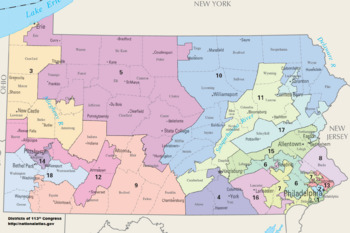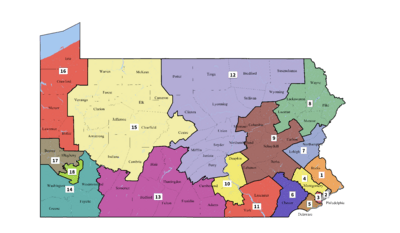League of Women Voters of Pennsylvania v. Commonwealth of Pennsylvania facts for kids
Quick facts for kids League of Women Voters of Pennsylvania v. Commonwealth of Pennsylvania |
|
|---|---|
 |
|
| Court | Supreme Court of Pennsylvania |
| Full case name | League of Women Voters, et al. v. the Commonwealth of Pennsylvania, et al. |
| Decided | January 22, 2018 |
| Case history | |
| Appealed from | Commonwealth Court of Pennsylvania |
| Subsequent action(s) | Opinion and Order Adopting Remedial Plan |
| Case opinions | |
| The Congressional Redistricting Act of 2011 was deemed an unconstitutional gerrymander, and the Pennsylvania congressional maps were ordered redrawn. | |
| Court membership | |
| Judges sitting | Thomas G. Saylor, Max Baer, Debra Todd, Christine Donohue, Kevin Dougherty, David Wecht, Sallie Mundy |
| Case opinions | |
| Decision by | Todd, Donohue, Dougherty, Wecht |
| Concur/dissent | Baer |
| Dissent | Saylor, Mundy |
League of Women Voters of Pennsylvania v. Commonwealth of Pennsylvania was an important case decided by the Pennsylvania Supreme Court. It was about how political maps are drawn, especially when they give one political party an unfair advantage. This is called gerrymandering. The Court decided that the maps made by the Republicans in 2011 were unfair. They said these maps went against the Constitution of Pennsylvania, the state's main set of rules.
Contents
Understanding Gerrymandering in Pennsylvania
Gerrymandering is when politicians draw voting district lines to help their own party win more elections. This can make it harder for voters to choose who they want. This case focused on how congressional districts were drawn in Pennsylvania.
How Pennsylvania's Political Maps Are Drawn
After the 2010 census, Pennsylvania needed to redraw its congressional districts. This happens every ten years. In 2010, the Republicans won many elections in Pennsylvania. Tom Corbett became governor. Republicans also gained control of the state House of Representatives. This meant they could control how the new district maps were drawn.
The 2011 Map: A Closer Look
In September 2011, Republican leaders in the state senate introduced a bill. This bill would create new congressional district lines. At first, the bill did not show the actual map. The map was added later, in December 2011.
The committee approved the map with a 6-5 vote. All Republicans voted for it, except for one. Republican Senator Mike Folmer voted against it. He said the map looked like it was made to weaken Democratic votes. Barry Kauffman, a lobbyist, agreed. He said the plan was "politicians picking their voters."
Debate Over the New Map
The bill then went to the full senate. Democrats tried to change the map. Democratic Senator Vincent Hughes argued that the Republican map would create many "safe" districts for Republicans. He said it would leave only a few "swing" districts. Swing districts are ones that could be won by either party. The Democrats' proposed map would have more swing districts.
The Democrats' change was voted down. The senate approved the Republican map by a close vote of 26-24. Then, the map went to the state House of Representatives. The House approved it 136-61. Some Democrats voted for the map, and some Republicans voted against it.
On December 22, 2011, Governor Corbett signed the new map into law. This map combined two Democratic representatives, Jason Altmire and Mark Critz, into one district. This made it harder for both of them to win. It also made six Republican districts safer.
The Lawsuit Against the Map
In June 2017, the League of Women Voters of Pennsylvania filed a lawsuit. They said the 2011 congressional map was an unconstitutional gerrymander. They argued it unfairly favored the Republican Party.
Court Decisions and Appeals
In December 2017, a Pennsylvania trial court looked at the case. The court found that the district lines were indeed drawn to favor Republicans. However, the court said it did not break state law. The League of Women Voters then appealed the decision. The case went to the Pennsylvania Supreme Court. The Supreme Court decided to review the case quickly.
On January 22, 2018, the Pennsylvania Supreme Court made its decision. It ruled that the existing map was unconstitutional. The Court said the map "clearly, plainly and palpably" violated the state constitution. They promised a full explanation later. The Court also set deadlines for the state government to create new maps.
Creating New District Maps
The Pennsylvania Supreme Court gave the state legislature a deadline. They had until February 9, 2018, to propose a new map. Then, the governor had until February 15, 2018, to send it to the court.
The legislature could not agree on a new plan by the deadline. So, on February 19, 2018, the Pennsylvania Supreme Court released its own new congressional map. This new map would be used for the May 15 primary elections.
After the Court's Decision
Republicans in Pennsylvania tried to challenge the Supreme Court's decision. They asked the United States Supreme Court to stop the new map from being used. However, their request was denied on February 5, 2018.
Republican lawmakers also filed a lawsuit in a federal court. They wanted to stop the court-drawn map from being used. But on March 19, 2018, the federal court ruled against them.
Attempt to Impeach Justices
In March 2018, some Republican state lawmakers tried to impeach the four justices who voted for the new map. Impeachment is a process to remove a public official from office. State Representative Cris Dush and 12 other Republicans said the justices had misused their power.
Chief Justice Thomas Saylor spoke out against this attempt. The effort to impeach the justices failed. This was because House Republican Leader David L. Reed decided not to support it.



